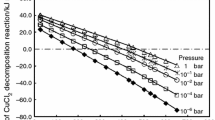Abstract
Copper oxychloride, Cu2OCl2, was synthesized from CuCl, or CuCl2·2H2O in a tubular furnace in a dry air atmosphere between 325 and 400 °C. Thermal gravimetric and gas analysis of the reaction products were used to follow the decomposition of Cu2OCl2 in both dry air and argon environments. The thermograms show the release of chlorine and oxygen gases, the volatilization of CuCl, and a residue, identified as CuO, of ~17 to 25% which varies as the conditions of the run. A mechanism of reaction able to describe the experimental results has been proposed and used to explain other published data.










Similar content being viewed by others
References
Brown LC, Funk JF, Showalter SK. Initial screening of thermochemical water-splitting cycles for high efficiency generation of hydrogen fuels using nuclear power. GAA23373 report. San Diego, CA: General Atomics; 2000.
Lewis MA, Masin JG, O’Hare PA. Evaluation of alternative thermochemical cycles, part I: the methodology. Int J Hydrogen Energy. 2009;34:4115–24.
Lewis MA, Masin JG. The evaluation of alternative thermochemical cycles—part II: the down-selection process. Int J Hydrogen Energy. 2009;34:4125–35.
Lewis MA, Ferrandon MS, Tatterson DF, Mathias P. Evaluation of alternative thermochemical cycles—part III further development of the Cu–Cl cycle. Int J Hydrogen Energy. 2009;34:4136–45.
Naterer GF, Suppiah S, Stolberg L, Lewis M, Wang Z, Gabriel K, Dincer I, Rosen MA, Spekkens P, Lvov S, Fowler M, Tremaine P, Mostaghimi J, Easton EB, Trevani L, Rizvi G, Ikeda BM, Kaye MH, Lu L, Pioro I, Smith WR, Secnik E, Jiang J, Avsec J. Canada’s program on nuclear hydrogen production and the thermochemical Cu-Cl cycle. Int J Hydrogen Energy. 2010;35:10905–26.
Zamfirescu C, Dincer I, Naterer GF. Thermophysical properties of copper compounds in copper–chlorine thermochemical water splitting cycles. Int J Hydrogen Energy. 2010;35:4839–52.
Naterer G, Suppiah S, Lewis M, Gabriel K, Dincer I, Rosen MA, Fowler M, Rizvi G, Easton EB, Ikeda BM, Kaye MH, Lu L, Pioro I, Spekkens P, Tremaine P, Mostaghimi J, Avsec J, Jiang J. Recent Canadian advances in nuclear-based hydrogen production and the thermochemical Cu–Cl cycle. Int J Hydrogen Energy. 2009;34:2901–17.
Wang Z, Naterer GF, Gabriel KS, Gravelsins R, Daggupati VN. Comparison of different copper–chlorine thermochemical cycles for hydrogen production. Int J Hydrogen Energy. 2009;34:3267–76.
Muradov NZ, Veziroglu TN. Green path from fossil-based to hydrogen economy: an overview of carbon-neutral technologies. Int J Hydrogen Energy. 2008;33:6804–39.
Litwin RZ, Pinkowski SM. Solar power for thermochemical production of hydrogen. US Patent US 7,726,127 B2, 2010.
Krivovichev SV, Filatov SK. The cuprite-like framework of OCu4 tetrahedra in the crystal structure of synthetic melanothallite, Cu2OCl2, and its negative thermal expansion. The Canadian Mineralogist. 2002;40:1185–90.
Kawashima K, Okabe H, Suzuki K, Kuroiwa S, Akimitsu J, Sato KH, Koda A, Kadono R. Antiferromagnetic ordering in Cu2OCl2 studied by the muon spin rotation/relaxation technique. J Phys Condens Matter. 2007;19:145275/1–145275/5.
Parry TJ. I. Thermodynamics and magnetism of Cu2OCl2, II. Repairs to microcalorimeter. MSc. Thesis, Brigham Young University; 2008.
Sharkey JB, Lewin SZ. Thermochemical properties of the copper hydroxychlorides. Thermochim Acta. 1972;3:189–201.
Ramamurthy P, Secco EA. Studies on metal hydroxy compounds. VII. Thermal analyses of copper derivatives. Can J Chem. 1969;47:2185–90.
Walter-Lévy L, Goreaud M. Sur la formation des chlorures basiques cuivriques par voie sèche. Thermolyse des chlorures neutres et basiques. Bull Soc Chim Fr. 1971;2:444–50.
Serban M, Lewis M, Basco JK. Kinetic study of the hydrogen and oxygen production reactions in the copper-chloride thermochemical cycle. In: AIChE 2004, Spring National Meeting New Orleans, LA, April 25–29, 2004.
Ferrandon MS, Lewis MA, Tatterson DF, Gross A, Doizi D, Croize L, Dauvois V, Roujou JL, Zanella Y, Carles P. Hydrogen production by the Cu–Cl thermochemical cycle: Investigation of the key step of hydrolysing CuCl2 to Cu2OCl2 and HCl using a spray reactor. Int J Hydrogen Energy. 2010;35:992–1000.
Li Z, Wang R, Zheng H, Xie K. Preparation of CuY catalyst using CuCl2 as precursor for vapour phase oxidative carbonylation of methanol to dimethyl carbonate. Fuel. 2010;89:1339–43.
De Micco G, Bohé AE, Pasquevich DM. A thermogravimetric study of copper chlorination. J Alloys Compd. 2007;437:351–9.
Herman F, Donald M, Charles FO, Glenn GO, Kirk TS. Othmer encyclopedia of chemical technology. 3rd ed. Canada: Wiley-Interscience; 1979.
Marin GD, Wang Z, Naterer GF, Gabriel K. Byproducts and reaction pathways for integration of Cu-Cl cycle of hydrogen production. Int J Hydrogen Energy. 2011. doi:10.1016/j.ijhydene.2011.07.103.
Acknowledgements
We are grateful to Professor Brad Easton (UOIT) and Dr. Mike Gorton (University of Toronto) for supplying the TG and XRD systems, Professor Gregory Hope from Griffith University, Australia, for the synthesis of one of the copper oxychloride samples used as reference material. This work could not be performed without the support of the University of Ontario Institute of Technology, Argonne National Laboratory, Atomic Energy of Canada Limited and the Ministry of Research and Innovation through the Ontario Research Fund-Research Excellence program. This work was also supported by the U.S. Department of Energy’s Fuel Cell Technologies Program Offices. Argonne National Laboratory is managed for the U.S. Department of Energy by University of Chicago Argonne, LLC, under contract DE-AC-02-06CH11357.
Author information
Authors and Affiliations
Corresponding author
Rights and permissions
About this article
Cite this article
Nixon, A., Ferrandon, M., Kaye, M.H. et al. Thermochemical production of hydrogen. J Therm Anal Calorim 110, 1095–1105 (2012). https://doi.org/10.1007/s10973-011-1998-3
Received:
Accepted:
Published:
Issue Date:
DOI: https://doi.org/10.1007/s10973-011-1998-3




